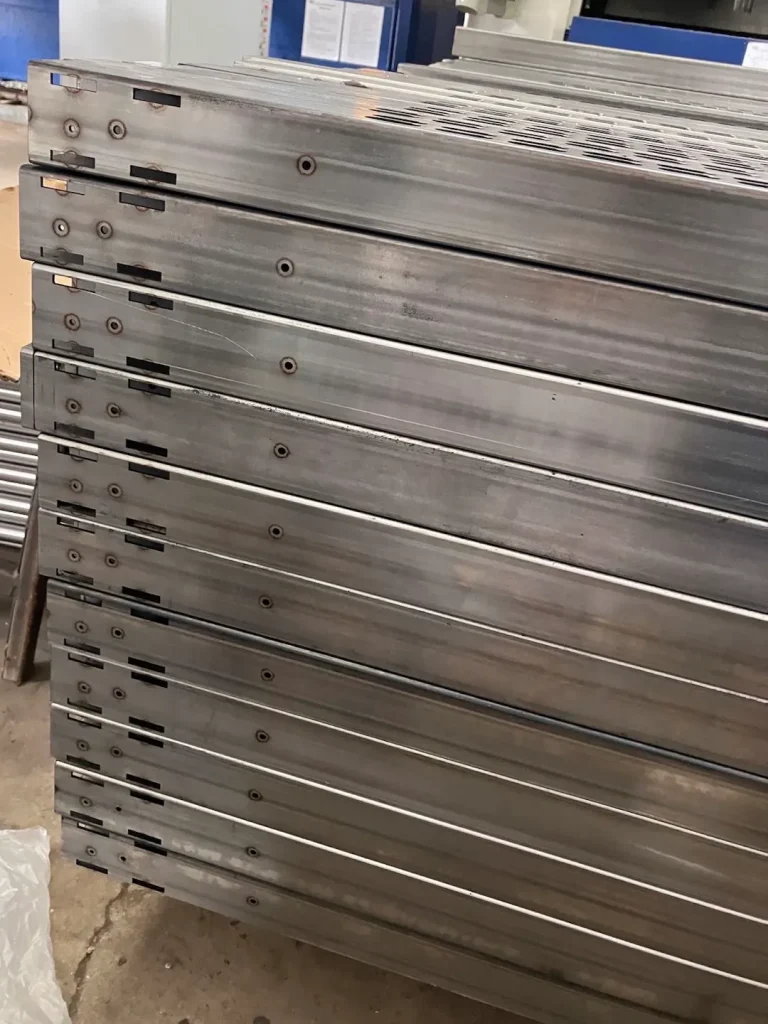Sommario
Panoramica & Casi d'uso
Able Hardware provides production-grade fiber laser cutting for both sheet/plate and tube, integrated with forming, lavorazione, saldatura, finitura, and export packaging. For OEM/ODM buyers, our laser cells deliver fast prototyping and repeatable volume runs with clean edges and stable dimensions ready for downstream assembly montature in metallo personalizzate e saldatura automatica.
Why this solution for precision, speed & cost control
Fiber lasers cut most engineering metals quickly with minimal heat-affected zone (HAZ). Assisted gases (N₂/O₂/Air) and optimized nesting reduce scrap; micro-joints e etch marking keep kits intact and traceable. Typical cut accuracy ±0.10–0.20 mm with kerf ≈0.10–0.30 mm helps engineers hit assembly stack-ups without costly secondary machining.
Industrie tipiche & applicazioni
- Attrezzature industriali & macchinari: base plates, guardie, parentesi, service panels.
- Warehouse/logistics: gussets and panels for carts/racks (Vedere /products/welding-trolley-carts/).
- Robotica & automazione: riser plates, cell panels, lightening patterns that bend cleanly.
- HVAC/electrical: enclosure plates, perforated doors, busbar covers.
- Automotive/agricultural: skid plates, tabs, chassis brackets ready for fixture welding.
Proprietà tecniche
Materiali, thickness ranges, kerf & tolleranze (ISO 9013/ISO 2768)
- Carbon steel: Q235/S235, Q355/S355, 0.8–25 mm
- Inossidabile: 304/316, 0.8–20 mm
- Alluminio: 5052/6061/6082, 0.8–15 mm
- Galvanized steel: per coating class; edge quality verified post-cut
- Bed sizes: 1250×2500, 1500×3000, 2000×4000 mm
- Dimensional: tipicamente ±0.10–0.20 mm (feature/geometry dependent) under ISO 2768-m/f
- Cut quality: ISO 9013 allineare 2–4 (specify per material/thickness)
- Kerf: ≈0.10–0.30 mm used for nesting and compensation
Limitazioni & design-for-laser guidelines (min holes/slots, radii)
- Min hole Ø ≈ 1.0–1.2× material thickness
- Min slot width ≈ material thickness + 0.2 mm
- Inside corners: add small fillets to reduce heat dwell and burr
- Tabs/bridges: sized per thickness to hold parts in sheet; removed in deburr
- Common-line cutting: permitted on compatible features to reduce burr/heat
- Etch marking: add shallow alphanumeric/part IDs for kitting (avoids labels during processing)
Opzioni di produzione
Cutting gases (N₂/O₂/Air), nesting & micro-joints; deburr, tap, countersink
- Assist gas:
- N₂ for stainless/aluminum cosmetic edges
- O₂ for thicker carbon steel throughput
- Air for cost-optimized runs (confirm edge spec)
- Nesting: yield-optimized layouts with kerf compensation e micro-joints for kit stability
- Post-cut prep: deburr/chamfer, countersink, tapping (M3–M12 typical), re-aming of precision holes
Operazioni secondarie: bending/forming, lavorazione, saldatura; rivestimento & confezione
- Formare: press-brake bending with bend deduction tables; flat-to-form workflows
- Lavorazione CNC: critical bores/faces when GD&T requires tighter than laser spec
- Saldatura: manual/robotic MIG (TIG if specified) a ISO 13920 A.C with ISO 5817 Classe C default (Classe B for visible joints), e ISO 2553 weld symbols; Vedere /services/automatic-welding/
- Finitura: cappotto in polvere (RAL, 70–100 µm), Zinco, E-coat, vernice industriale; surface prep to ISO 8501, coating selection by environment per ISO 12944; Vedere /services/powder-coating/
- Imballaggio per l'esportazione: pallet/crate, interleaf to protect surfaces, labeled kits with barcodes and piece counts for line-side assembly
Tipi & Geometria
Common part families (parentesi, pannelli, tasselli, base plates, perforations) & sheet size bands
- Flat panels & doors (≤2000×4000 mm) with louvers/perforations
- Angle brackets & tasselli with reliefs that bend cleanly after cutting
- Base plates with slot/hole patterns for adjustable mounting
- Perforated guards & screens with tuned open-area ratios
- Kitted blanks for frames/carts that proceed to bending/welding
Qualità & Test
Ciò che verifichiamo (dimensional check, edge quality; DFT to ISO 2808) e documentazione (CoC, rapporti di ispezione)
- In-process: dimensional checks vs DXF/DWG, edge burr & HAZ review, flatness sampling for large plates
- After finishing: DFT measured to ISO 2808, adhesion checks as specified
- Documents: CoC, rapporti di ispezione, material traceability and lot labels.

Fiber laser cutting steel 2 mm, N₂ assist, clean edge
Prezzi & Tempi di consegna
Moq, Politica di esempio, Driver di costo indicativi (Nessun prezzo duro)
- Moq: flessibile; prototype lots accepted to prove fit/form/function
- Samples: quick-turn laser blanks available prior to forming/welding
- Tempi di consegna: rapid prototypes in days; production lots typically 1–3 weeks depending on forming/welding/finish queues
- Cost drivers: material grade/thickness, sheet utilization (nest yield), part count and pierces, assist gas, tolerance class, deburr level, tapped holes/countersinks, forming steps, lunghezza della saldatura, coating type/DFT, and packaging specification
Standard & Conformità
Standard/certificazioni pertinenti & Documentazione fornita (ISO 9013, ISO 2768, ISO 13920, ISO 2553, ISO 5817, ISO 12944, ISO 8501)
- Cut quality: ISO 9013
- General tolerances: ISO 2768-m/f
- Weld fabrication: ISO 13920 A.C, ISO 2553 symbols
- Weld acceptance: ISO 5817 (Class C standard, Class B for visible joints)
- Rivestimenti: ISO 12944 (environmental category) and surface prep ISO 8501
- Full inspection/traceability package available on request.
FAQ
What metals and grades do you cut?
Q235/S235, Q355/S355, 304/316 inossidabile, 5052/6061/6082 alluminio, e acciaio zincato. Specify finish condition (per esempio., 2B, brushed) if cosmetic.
What thickness limits apply?
Typical ranges: steel 0.8–25 mm, stainless 0.8–20 mm, aluminum 0.8–15 mm. We’ll confirm cut quality class (ISO 9013 2–4) by material and thickness.
What tolerances should I call out?
Use ISO 2768-m/f for non-critical features; specify GD&T for critical bores/faces. As-cut accuracy is commonly ±0.10–0.20 mm with kerf ≈0.10–0.30 mm.
Any design rules for holes and slots?
Min hole ≈1.0–1.2× thickness; min slot ≈ thickness + 0.2 mm. Add small inside radii and avoid knife-edge features to improve edge quality and bend consistency.
Can you bend, saldare, and coat after cutting?
Yes—forming, lavorazione, MIG/TIG welding to ISO 13920 with ISO 5817 acceptance, and powder coat/e-coat/zinc plating per ISO 12944. Vedere /services/automatic-welding/ e /services/powder-coating/.
What about tube laser cutting?
We cut both sheet/plate and tube profiles (slots, copes, tab-and-slot for jig-free fit-up) and can deliver welded assemblies ready for installation.
What files do you accept?
DXF/DWG for flat parts; STEP/IGES for formed/welded assemblies. Include material, spessore, quantità, tolleranze, fine, and packing notes.
Upload your drawing to get a fast, engineered quote
Send DXF/DWG/STEP with quantities and finish notes. We’ll return manufacturability feedback, nest yield, and a firm schedule.